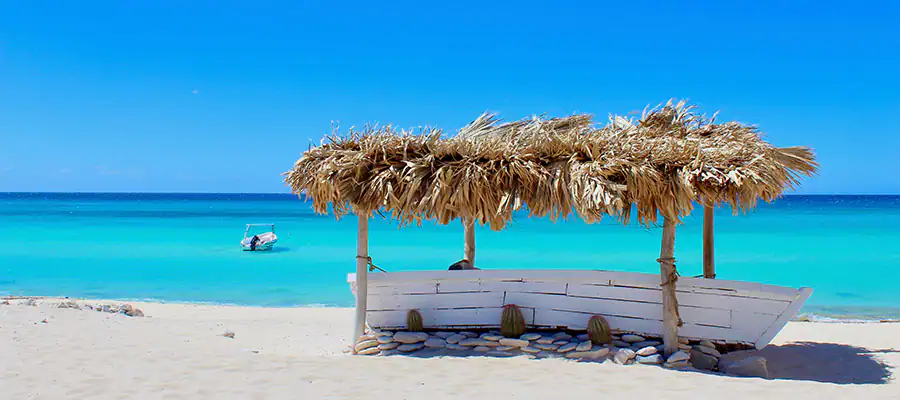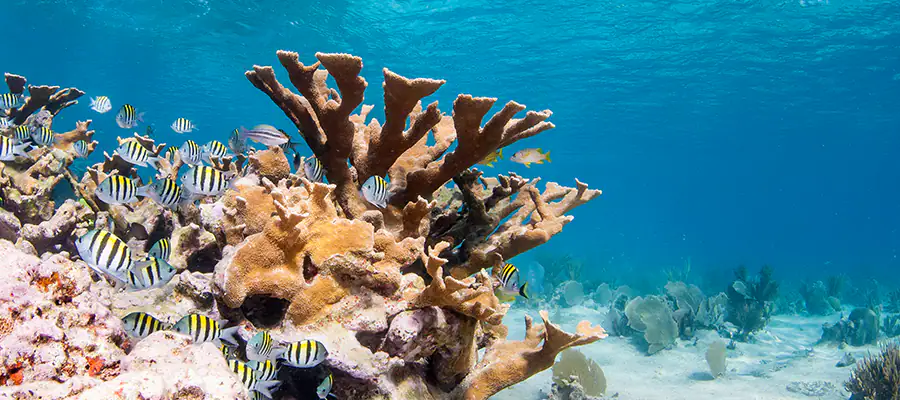Cabo Rojo Unveiled: Dominican Republic's Coastal Jewel

Cabo Rojo is one of the most beautiful places on the south coast of the Dominican Republic, about twenty kilometers from Pedernales and 120 km from Barahona. Located near Bahia de las Aguilas, it is one of the province’s most popular beaches.
Its name comes from the abundant bauxite in the surroundings, and it remained closed for years. Access to Cabo Rojo is not as easy as other tourist destinations in the Dominican Republic due to the lack of tourist investment in the area and its semi-pristine conditions. However, these conditions add to the place’s allure, ensuring that once you reach the beach, you experience complete immersion in nature. Visits are regularly conducted in the region, but some prefer to approach the area in a particular way.
Cabo Rojo’s crystal-clear waters stand out as the best-preserved coral reefs in the Caribbean Sea region. From the shore, the beach exhibits an intense turquoise blue. The coasts are favorable areas for the West Indian manatee, an endemic species of the Dominican Republic, and for the nesting of hawksbill turtles. Pelicans also abound along its shores in impressive flocks.
The inhabited areas consist of a typical fishing village. Full of picturesque wooden houses, it is common to see fishermen at work from the shore. It is the perfect place for ecotourism and to enjoy nature in its most natural state.
Things to do in Cabo Rojo

Cabo Rojo is a hidden gem on the south coast of the Dominican Republic. This coastal paradise is not just about pristine beaches; it offers a myriad of experiences for those seeking adventure, cultural immersion, and a deep connection with nature. Let’s explore the top things to do in Cabo Rojo for an unforgettable getaway.
- Discover Playa Bahia de las Aguilas: Start your Cabo Rojo adventure with a visit to Playa Bahia de las Aguilas, one of the most breathtaking beaches in the region. Enjoy the powdery white sand and crystal-clear waters, perfect for swimming, sunbathing, and beachcombing.
- Snorkeling and Diving Adventures: Dive into Cabo Rojo’s underwater wonders with snorkeling and diving expeditions. Explore vibrant coral reefs teeming with marine life, and discover the magic beneath the surface of the turquoise waters.
- Relaxation and Wellness: Unwind and rejuvenate in Cabo Rojo’s serene atmosphere. Consider yoga on the beach, spa treatments, or simply lounging in a hammock with the sound of the waves as your backdrop.
- Jaragua National Park:Exploring Jaragua National Park offers a diverse range of activities for nature lovers, adventure seekers, and those interested in cultural exploration. Here are some things to do in Jaragua National Park:
- Hiking Trails: Embark on scenic hikes through the park’s diverse landscapes. Trails like the Los Cerros de Enriquillo offer breathtaking views of the surrounding hills, while the El Quita Espuela trail takes you through dry forests teeming with unique flora and fauna.
- Beach Bliss at Bahia de las Aguilas: Visit Bahia de las Aguilas, a pristine and secluded beach within the park. With its powdery white sands and crystal-clear waters, it’s a perfect spot for swimming, sunbathing, and enjoying the untouched beauty of the Caribbean coastline.
- Bird Watching: Jaragua is a paradise for bird watchers. Bring your binoculars and explore the park’s diverse habitats to spot a variety of bird species, including flamingos, herons, and the endangered Ridgway’s Hawk.
- Explore Caves and Taino Rock Art: Delve into the park’s cultural heritage by exploring limestone caves adorned with ancient Taino rock art. These petroglyphs offer a fascinating glimpse into the indigenous history of the Dominican Republic.
- Wildlife Safari: Take a wildlife safari to encounter the park’s diverse fauna. Keep an eye out for Rhinoceros Iguanas, an endangered species that finds refuge in Jaragua, along with other reptiles, mammals, and marine life.
- Snorkeling and Diving: Explore the marine wonders of Jaragua by snorkeling or diving in the clear waters. Discover vibrant coral reefs, tropical fish, and maybe even catch a glimpse of the elusive West Indian manatee in designated areas.
- Boat Tours to Isla Beata: Embark on a boat tour to Isla Beata, an island just off the coast of Jaragua. This excursion offers a chance to relax on pristine beaches, explore coastal ecosystems, and experience the charm of a less-visited island.
- Fishing Expeditions: If you enjoy fishing, consider joining a local fishing expedition. The coastal waters around Jaragua National Park are rich in marine life, providing a rewarding experience for fishing enthusiasts.
- Photography Safari: Capture the beauty of Jaragua’s landscapes, wildlife, and cultural sites through a photography safari. The park’s diverse scenery provides ample opportunities for stunning shots.
- Camping and Stargazing: For a truly immersive experience, camp within the park and witness the breathtaking night sky. Jaragua’s remote location ensures minimal light pollution, creating a perfect setting for stargazing.
- Laguna de Oviedo: Offers a range of activities for nature lovers and adventure seekers. Here are some things to do in Laguna de Oviedo:
- Boat Tour: Embark on a boat tour to navigate the tranquil waters of Laguna de Oviedo. Knowledgeable guides will provide insights into the lake’s biodiversity, including bird species and other wildlife.
- Bird Watching: Laguna de Oviedo is a birdwatcher’s paradise. Bring binoculars to observe a variety of bird species, including flamingos, herons, and pelicans, against the picturesque backdrop of the lake.
- Flamingo Observation: Witness the graceful presence of flamingos, a prominent resident species in the lagoon. Capture stunning photographs of these elegant birds as they wade through the shallow waters.
- Mangrove Exploration: Explore the mangrove forests surrounding the lake. Take a guided tour to learn about the importance of mangroves in supporting marine life and protecting the shoreline.
Remember to check with local authorities or park rangers for any guidelines or restrictions before engaging in certain activities to ensure a respectful and responsible visit to Jaragua National Park.
Conclusion: Cabo Rojo is a destination that goes beyond the ordinary, offering a tapestry of experiences for every type of traveler. Whether you seek adventure, cultural immersion, or relaxation, Cabo Rojo invites you to create memories that will last a lifetime. Pack your sense of adventure and embark on a journey to discover the magic of this coastal haven.

Dive into Paradise: Exploring the Best of Cabo Rojo, Dominican Republic
Cabo Rojo’s underwater world stands as a diver’s paradise, boasting some of the Caribbean’s best-preserved coral reefs. Home to West Indian manatees and hawksbill turtles, the sea bottom teems with vibrant marine life. Dive into this unique experience, whether you’re an experienced diver or a beginner eager to learn. Classes are available for novices, drawing thousands each year to explore the mesmerizing depths.
As you submerge into the sea, marvel at the delicate coral formations. Exercise caution not to touch them, as their fragility requires protection. Opt for reef-safe sun protection to contribute to the preservation of these underwater wonders.
Encounter the grandeur of hawksbill turtles, a protected species admired for their underwater grace. As we strive to safeguard their existence, participating in responsible diving practices becomes paramount. Cabo Rojo, with its rich marine life and pristine waters, promises an immersive journey into the wonders of the Caribbean’s underwater realm.
Navigating Paradise: A Guide on How to Get to Cabo Rojo, Pedernales
Cabo Rojo in Pedernales, Dominican Republic, beckons with its pristine beaches, vibrant culture, and underwater wonders. To embark on this tropical adventure, it’s crucial to plan your journey wisely. In this guide, we’ll explore the best ways to reach Cabo Rojo, ensuring your arrival is as seamless as the turquoise waters that await.
Choosing Your Starting Point: Before you set out on your journey to Cabo Rojo, decide on your starting point. The capital, Santo Domingo, is approximately 300 kilometers away and serves as a common departure city.
By Air: Cabo Rojo Airport is a coastal airport situated along the Caribbean in the Dominican Republic, approximately 16 kilometers southeast of the town of Pedernales.
By Car: Renting a car provides flexibility and convenience, allowing you to explore the stunning scenery at your own pace. The journey from Santo Domingo takes approximately 4 hours and 45 minutes, offering the chance to witness the changing landscapes as you approach Cabo Rojo.
By Taxi: For those preferring a more relaxed journey, hiring a taxi is a comfortable option. Taxi services are available in Santo Domingo, providing a hassle-free ride directly to Cabo Rojo. While it may be a bit pricier than other options, the convenience is worth considering.
By Bus: Public buses do operate in the Dominican Republic, but it’s important to note that they don’t offer a direct route to Cabo Rojo. Buses from Santo Domingo typically terminate in Barahona. From there, you’ll need to hire a taxi for the remaining 123 kilometers to reach Cabo Rojo. While this option is more economical, it may be less convenient, especially if you’re carrying a lot of luggage.
Navigating the Last Stretch: Cabo Rojo’s charm lies in its remoteness, making the final leg of your journey an adventure in itself. The roads wind through picturesque landscapes, revealing the untouched beauty of the region.
Conclusion: Getting to Cabo Rojo in Pedernales is a journey worth taking. Whether you choose the flexibility of a rental car, the convenience of a taxi, or the adventure of combining bus and taxi travel, the destination promises an immersive experience. As you approach Cabo Rojo, the anticipation builds, setting the stage for a tropical getaway that combines natural beauty, cultural richness, and the allure of the Caribbean’s hidden gems.
Frequently Asked Questions
Cabo Rojo in Pedernales is unique for its pristine beaches, vibrant culture, and untouched natural beauty. It offers a tranquil escape away from more touristy areas, providing a genuine and immersive experience.
To reach Cabo Rojo from Santo Domingo, you can either rent a car for a scenic 4-hour and 45-minute drive or hire a taxi. Public buses are also available, but they typically end their journey in Barahona, requiring a taxi for the remaining 123 kilometers.
Cabo Rojo has the domestic Cabo Rojo Airport (CBJ) and also travelers can fly into Maria Montez International Airport in Barahona and then drive or take a taxi to reach Cabo Rojo.
Cabo Rojo is known for its incredible white sand beach, mangrove exploration, and the stunning Bahia de las Aguilas. The area is also famous for its red-hued paths, named after the mineral bauxite.
Absolutely. Cabo Rojo is a paradise for diving enthusiasts. The sea bottom features some of the best-preserved coral reefs in the Caribbean, and the area is home to West Indian manatees and hawksbill turtles.
Yes, Cabo Rojo offers cultural experiences, particularly in the nearby fishing villages. Visitors can interact with locals, observe traditional fishing practices, and gain insights into the authentic way of life in this coastal region.
The dry season, from November to April, is considered the best time to visit Cabo Rojo, offering ideal weather conditions for beach activities and outdoor exploration. However, the shoulder seasons of May-June and September-October provide fewer crowds and pleasant weather for a more tranquil experience.







 French
French German
German Portuguese
Portuguese Spanish
Spanish